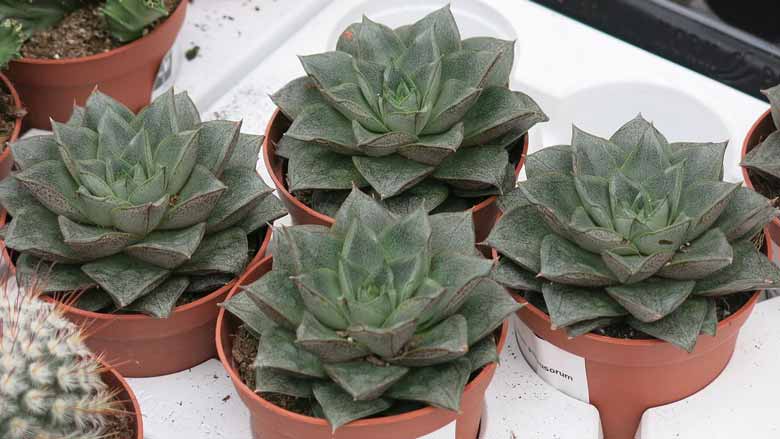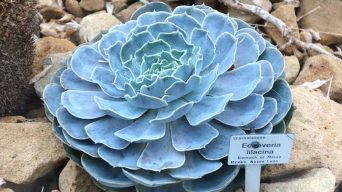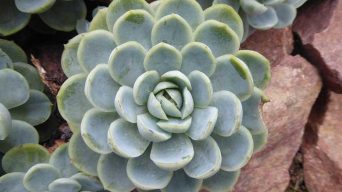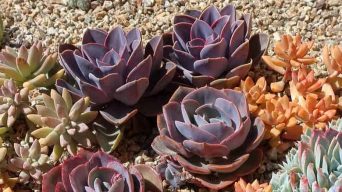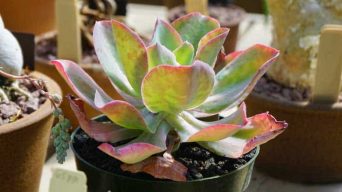Echeveria purpusorum is a succulent plant that is native to Mexico.
Echeverias are known for their wide range of colors, shapes, sizes, textures, and growth patterns.
This Echeveria species has been popularized by its beautiful dark green leaves with red spots on rosette-shaped stems and red-orange flowers.
This guide will teach you all about Echeveria purpusorum care, propagation techniques, and more!
Overview
Echeveria purpusorum is a Mexican succulent plant with dark green leaves with red spots.
As the plant grows, it can reach up to about 6 inches (15 cm) tall and wide.
The extent to which the leaves turn brown, green, or red is determined by the amount of sunlight it receives.
This slow-growing succulent plant rarely blooms, producing flowers of a reddish-orange color on tall stalks.
How To Care for Echeveria Purpusorum
Echeveria purpusorum care should be easy due to its hardy nature. It only takes a little bit of care each day to maintain this Echeveria.
There are a few basic guidelines to follow in order to keep Echeveria purpusorum healthy. Below are some Echeveria purpusorum care tips.
Sun Exposure & Light Requirements
Echeveria purpusorum plants need partial sun in a partially shaded location. They will also tolerate a shady place with some light.
The Echeveria purpusorum plant prefers lower sun exposure in its natural habitat. For this reason, they like it when their leaves are not directly exposed to full sunlight during the day.
However, like most succulents, Echeverias need abundant bright light if they grow properly and thrive indoors or outdoors as an ornamental garden plant.
If your plants are indoors, give them bright indirect light from a window.
This means that you should give them an east window (morning) or west window (afternoon), so they receive at least six hours per day of dappled sunlight – but never direct midday sun!
When grown outside, Echeveria purpusorum plants prefer to be positioned in a garden spot that gets morning sun, as they will get scorched if left out in direct afternoon sun.
Watering Requirements
The Echeveria purpusorum succulent will need a thorough watering every two weeks to thrive and keep its leaves from wilting.
Generally, it is best to allow pot plants with large fleshy roots (such as this plant) to dry out between waterings.
This plant will only require watering when the top inch of soil feels dry.
Make sure not to let water sit in the Echeveria’s rosette because this will cause rot.
Soil Requirements
Echeveria Purpusorum is a succulent plant that requires a well-draining soil. The soil should be porous and allow water to drain through it.
A cactus or succulent soil mix is ideal for this plant.
You can also create your own Echeveria soil mix by combining one part cacti and succulent potting soil with two parts sand or perlite.
A general mix can include potting soil with sand or perlite added to provide better air circulation for the roots.
Some people say Echeverias prefer soils without organic matter as it tends to rot their root systems, so adding small pebbles instead will also help improve drainage and aeration.
Temperature and Humidity
Echeveria Purpusorum plants need a temperature range of 40-80°F.
Temperatures below 40°F will result in the Echeveria foliage turning black and falling off.
Temperatures over 80°F for extended periods can cause Echeverias to become sunburned or develop root rot, with leaves wilting and discoloration occurring on the stem tips.
Echeveria purpusorum plants need a humidity range of 40-50%.
Excessive humidity can cause the Echeveria to rot, with leaves wilting and discoloration occurring on the stem tips.
Low humidity will result in all of the Echeverias foliage turning black as it dies off.
Fertilizing
Echeveria purpusorum plants do not need a lot of fertilizer.
In fact, too much fertilizer can be detrimental to the plant’s health and development.
A diluted solution should suffice for fertilizing Echeveria purpusorum’s soil during the spring months. Still, you also want to ensure they are watered thoroughly after applying the fertilizer.
During the winter months, Echeveria purpusorum shouldn’t be fertilized.
Potting and Repotting
The Echeveria purpusorum is a small, slow-growing succulent that is best suited for small pots.
To pot your Echeveria, move them from their old pots into new ones and fill them up with potting mix so they’re just below the surface.
Water well after potting as this will help settle any air pockets around roots. You may have noticed that the Echeverias leaves look plump and healthy at this point.
The Echeveria can be Repotted whenever it shows signs of dehydration or when the plant has outgrown its container.
It’s best to do this in springtime, just after blooming, so that new growth will have time to harden off before winter sets in.
Echeverias are not built for much root room due to their small size. Their delicate leaves don’t need more space than they already have (many succulents die from transplant shock).
So keep them snug until you see roots coming up through drainage holes at the bottom of your pot, then make sure there’s enough soil above those roots and water well!
Pruning
Although Echeveria purpusorum plants need little maintenance, they need occasional pruning to remain healthy and attractive.
Use a clean, sharp blade when it is time to prune your Echeveria.
You just need to remove any dead leaves or those that are below the soil line so they do not rot and cause fungus to grow on your plant.
Cut away damaged sections of Echeveria leaf blades with scissors (or cut them very close to the base).
Don’t be too aggressive. Just trim off the damaged sections. Never remove Echeveria’s outer leaves (known as rosettes).
These plants are very slow-growing, so cutting them back will make for an unattractive Echeveria plant in a few months.
Pests and Diseases
Echeveria succulents tend to attract some bugs. Mealybugs, aphids, and mites are among the most common pests that affect Echeverias.
These bugs can spread disease if they are not detected early on, so it’s important to look for these pests as soon as possible before more damage is done.
To help prevent Echeveria succulents from attracting pest insects, make sure that plants have good air circulation around them at all times.
A beneficial predator of Echeveria pests is a ladybug or lacewing larvae. However, you need to observe Echeverias closely to spot an infestation quickly enough to take advantage of this method.
The Echeveria succulent plant can also be affected by fungal diseases, typically caused by overwatering or poor air circulation.
To prevent Echeveria succulents from contracting fungal diseases, make sure that plants have enough space to breathe and do not provide too much water at any time of the year.
It’s also important to avoid overhead watering, as it can lead to disease or rot on Echeverias.
How to Care for Echeveria Purpusorum in Winter
The Echeveria purpusorum is not a cold-hardy plant, so you need to take special care of it during winter.
The below tips will help you care for your Echeveria purpusorum succulent plant in the winter:
- The Echeveria purpusorum plant needs to be brought indoors in winter. If it is too cold, the Echeveria succulent can get damaged by low temperatures.
- Place the Echeveria plant in a bright and sunny place where it will not be exposed to drafts or extreme temperature fluctuations.
- Avoid dark areas such as storage rooms and basements because this would cause their coloration to weaken over time, leading them to turn white with brown spots on top.
- A south-facing window should offer enough light for your Echeveria plants all day long without burning them up when there’s sun outside from morning till evening hours.
- Allow Echeveria purpusorum to take a rest during winter by cutting back on the watering and fertilizer schedule.
- Protect Echeveria purpusorum from frost by moving them to a warmer location indoors.
- Move Echeveria Purpusorum to a brighter location outdoors when the weather warms up.
- Begin following the Echeveria purpusorum care regimen again when it starts to look less stressed.
How To Propagate Echeveria Purpusorum
Echeveria purpusorum propagation is relatively simple and can be done by leaves, seeds, or offsets.
Propagating Echeveria Purpusorum From Leaves
The Echeveria purpusorum plant can be propagated by taking a leaf from the Echeveria purpusorum plant and allowing it to be callous for a few days.
Then plant the Echeveria purpusorum leaf into a well-draining succulent soil mix.
It will take a few weeks for Echeveria purpusorum leaf cuttings to root.
Propagating Echeveria Purpusorum From Seeds
Succulents can also be propagated by planting the seeds in potting soil or a well-draining succulent mixture and keeping it moist until the seedlings have sprouted.
Misting every day with water will help prevent echeveria plant seeds from drying out, leading to a failed attempt at propagation.
Seeds take about two weeks before they are ready to transplant into larger pots if desired and one year for full growth when planted directly outside their natural environment.
Propagating Echeveria Purpusorum From Offsets
Echeveria purpusorum can also be propagated by taking offsets (pups) from the mother plant.
Remove Echeveria purpusorum offsets with a sharp knife and allow them to be callous for about two days. Then place the Echeveria plant pups into a well-draining succulent soil mix and keep moist until roots have sprouted.
Echeveria plants take around three months before they are ready to be transplanted into larger pots and one year for full growth when planted directly outside their natural environment.
Is the Echeveria Purpusorum Toxic?
The Echeveria purpusorum can be toxic to humans and pets if ingested. It can cause nausea, vomiting, and diarrhea.
It is recommended to keep Echeveria purpusorum out of reach of children and pets as best as you can!
Final Thoughts
Echeveria purpusorum care is not too difficult.
It will require a few minutes each week to maintain Echeveria’s health, but it can be quite rewarding for such minimal effort.
The Echeveria plant does make an excellent houseplant because of its ease of care and adaptability.
If you’re looking at Echeveria purpusorum care as a potential gardening hobby, it’s worth giving it some thought.

